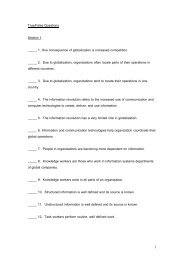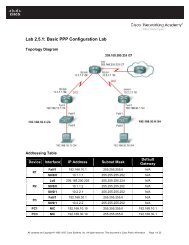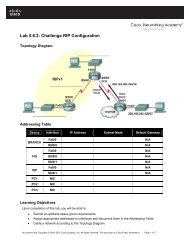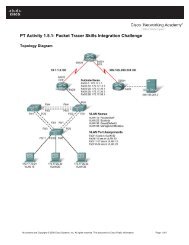Model management subsystem
Model management subsystem
Model management subsystem
Create successful ePaper yourself
Turn your PDF publications into a flip-book with our unique Google optimized e-Paper software.
DSS Description
Components of DSS
Components of DSS• Database <strong>management</strong> system (DBMS)Software for establishing, updating, and querying(e.g., managing) a database• Data warehouseA physical repository where relational data areorganized to provide clean, enterprise-wide datain a standardized format• DatabaseThe organizing of files into related units that arethen viewed as a single storage concept. Thedata in the database are generally made availableto a wide range of users
Components of DSS• <strong>Model</strong> <strong>management</strong> <strong>subsystem</strong>– <strong>Model</strong> base <strong>management</strong> system (MBMS)Software for establishing, updating, combining,and so on (e.g., managing) a DSS model base• User interfaceThe component of a computer system thatallows bidirectional communication betweenthe system and its user
Components of DSS• Knowledge-based <strong>management</strong><strong>subsystem</strong>– The knowledge-based <strong>management</strong><strong>subsystem</strong> can support any of the other<strong>subsystem</strong>s or act as an independentcomponent– Organizational knowledge baseAn organization’s knowledge repository
Data Management Subsystem• The data <strong>management</strong> <strong>subsystem</strong> iscomposed of”– DSS database– DBMS– Data directory– Query facility
Data Management Subsystem
Data Management Subsystem• The Database– Internal data come mainly from the organization’stransaction processing system– External data include industry data, marketresearch data, census data, regional employmentdata, government regulations, tax rate schedules,and national economic data– Private data can include guidelines used byspecific decision makers and assessments ofspecific data and/or situations
Data Management Subsystem• Data extractionThe process of capturing data from severalsources, synthesizing them, summarizingthem, determining which of them are relevant,and organizing them, resulting in theireffective integration
Data Management Subsystem• Database <strong>management</strong> system (DBMS)• Software for establishing, updating, andquerying (e.g., managing) a database• Query FacilityThe (database) mechanism that acceptsrequests for data, accesses them,manipulates them, and queries them• DirectoryA catalog of all the data in a database or allthe models in a model base
Data Management Subsystem• Key database and database <strong>management</strong>system issues– Data quality– Data integration– Scalability– Data security
The <strong>Model</strong> Management Subsystem
The <strong>Model</strong> Management Subsystem• <strong>Model</strong> baseA collection of preprogrammed quantitativemodels (e.g., statistical, financial,optimization) organized as a single unit
The <strong>Model</strong> Management Subsystem• Four categories of models with the modelbase– Strategic models– Tactical models– Operational models– Analytical models
The <strong>Model</strong> Management Subsystem• Strategic models<strong>Model</strong>s that represent problems for thestrategic level (i.e., executive level) of<strong>management</strong>• Tactical models<strong>Model</strong>s that represent problems for thetactical level (i.e., midlevel) of <strong>management</strong>
The <strong>Model</strong> Management Subsystem• Operational models<strong>Model</strong>s that represent problems for theoperational level of <strong>management</strong>• Analytical modelsMathematical models into which data areloaded for analysis
The <strong>Model</strong> Management Subsystem• <strong>Model</strong> building blocks and routines– <strong>Model</strong> building blocksPreprogrammed software elements that can beused to build computerized models. For example,a random-number generator can be employed inthe construction of a simulation model• <strong>Model</strong> components for building DSS• <strong>Model</strong>ing tools
The <strong>Model</strong> Management Subsystem• <strong>Model</strong> base <strong>management</strong> system: MBMSsoftware has four main functions– <strong>Model</strong> creation, using programming languages,DSS tools and/or subroutines, and other buildingblocks– Generation of new routines and reports– <strong>Model</strong> updating and changing– <strong>Model</strong> data manipulation
The <strong>Model</strong> Management Subsystem• <strong>Model</strong> directory– <strong>Model</strong> execution is the process of controlling theactual running of the model– <strong>Model</strong> integration involves combining theoperations of several models when needed– A model command processor is used to acceptand interpret modeling instructions from the userinterface component and route them to theMBMS, model execution, or integration functions
Knowledge-BasedManagement Subsystem• Advanced DSS are equipped with acomponent called a knowledge-based<strong>management</strong> <strong>subsystem</strong> that can supply therequired expertise for solving some aspects ofthe problem and provide knowledge that canenhance the operation of other DSScomponents
User Interface (Dialog) Subsystem• User interfaceThe component of a computer system thatallows bidirectional communication betweenthe system and its user.• User interface <strong>management</strong> system (UIMS)The DSS component that handles allinteraction between users and the system
User Interface (Dialog) Subsystem
DSS developments• DSS developments– Parallel processing hardware and softwaretechnologies have made major inroads in solvingthe scalability issue– Web-based DSS have made it easier and lesscostly to make decision-relevant information andmodel-driven DSS available to users ingeographically distributed locations, especiallythrough mobile devices
DSS developments– Parallel processing hardware and softwaretechnologies have made major inroads in solvingthe scalability issue– Web-based DSS have made it easier and lesscostly to make decision-relevant information andmodel-driven DSS available to users ingeographically distributed locations, especiallythrough mobile devices
DSS developments• DSS developments– Artificial intelligence continues to make inroads inimproving DSS• Faster, intelligent search engines• Intelligent agents promise to improve the interface inareas such as direct natural language processing andcreating facial gestures– The development of ready-made (or near-readymade)DSS solutions for specific marketsegments has been increasing
The User• The person faced with a decision that an MSSis designed to support is called the user, themanager, or the decision maker• MSS has two broad classes of users:managers and staff specialists– Staff specialists use the system much morefrequently than manager and tend to be moredetail-oriented– Staff analysts are often intermediaries betweenmanagers and staff specialists
The User• IntermediaryA person who uses a computer to fulfillrequests made by other people (e.g., afinancial analyst who uses a computer toanswer questions for top <strong>management</strong>)– Staff assistantAn individual who acts as an assistant to amanager
The User– Expert tool userA person who is skilled in the application of one ormore types of specialized problem-solving tools– Business (system) analystsAn individual whose job is to analyze businessprocesses and the support they receive (or need)from information technology– Facilitators (in a GSS)A person who plans, organizes, and electronicallycontrols a group in a collaborative computingenvironment
DSS Characteristicsand Capabilities
DSS Classifications• AIS SIGDSS classification for DSS– Communications-driven and group DSS (GSS)– Data-driven DSS– Document-driven DSS– Knowledge-driven DSS, data mining, and<strong>management</strong> ES applications– <strong>Model</strong>-driven DSS– Compound DSS
DSS Classifications• Holsapple and Whinston’s classification– Text-oriented DSS– Database-oriented DSS– Spreadsheet-oriented DSS– Solver-oriented DSS– Rule-oriented DSS
DSS Classifications• Alter’s output classification– Data• File drawer systems• Data analysis systems– Data or models• Analysis information systems– <strong>Model</strong>s• Accounting models• Representational models• Optimization models• Suggestion models
DSS Classifications• Other DSS categories– Institutional DSSA DSS that is a permanent fixture in anorganization and has continuing financial support.It deals with decisions of a recurring nature– Ad hoc DSSA DSS that deals with specific problems that areusually neither anticipated nor recurring
DSS Classifications• Other DSS categories– Personal support– Group support– Organizational support– Group support system (GSS)Information systems, specifically DSS, thatsupport the collaborative work of groups• Custom-made systems versus ready-madesystems
















